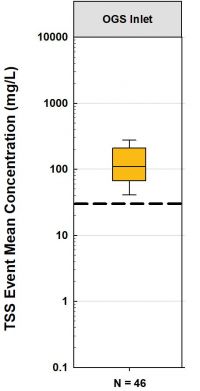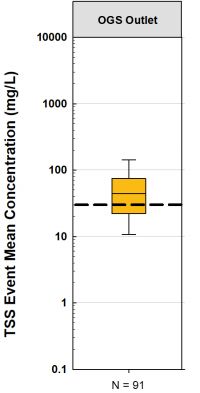OGS: Performance
TSS Reduction[edit]
Inlet[edit]
The performance results for OGS practices, located within TRCA's watershed originate from three primary sites:
- Woodside SmartCentre (Markham)
- North Queen Street & The Queensway (Etobicoke)
The mean performance value recorded at the inlet for OGS practices' ability to remove Total Suspended Sediments (TSS) was was calculated based on 46 separate recordings between 1997 - 1998 amongst the two sites previously mentioned.
As can be seen in the corresponding boxplot the mean performance removal efficiency of the OGS practices monitored are well below the suggested guideline of 30 mg/L (Canadian Water Quality Guideline (CWQG), or (background (assumed at <5 mg/L)+ 25 mg/L for short term (<24 hour) exposure) (CCME, 2002[1]; (TRCA, 2021[2]).
The median value of the 46 samples taken was 109.50 mg/L whereas the mean was 145.07 mg/L, with a 96% guideline exceedance.
Outlet[edit]
The performance results for OGS practices, located within TRCA's watershed originate from three primary sites:
- Woodside SmartCentre (Markham)
- North Queen Street & The Queensway (Etobicoke)
The mean performance value recorded at the inlet for OGS practices' ability to remove Total Suspended Sediments (TSS) was was calculated based on 46 separate recordings between 1997 - 1998 amongst the two sites previously mentioned.
As can be seen in the corresponding boxplot the mean performance removal efficiency of the OGS practices monitored are well below the suggested guideline of 30 mg/L (Canadian Water Quality Guideline (CWQG), or (background (assumed at <5 mg/L)+ 25 mg/L for short term (<24 hour) exposure) (CCME, 2002[3]; (TRCA, 2021[4]).
The median value of the 91 samples taken was 44.50 mg/L whereas the mean was 64.60 mg/L, with a 61% guideline exceedance. Given the age of of these practices and the dates monitoring took place, these systems will likely need major maintenance and/or rehabilitation if not full replacement, as they near the end of their working lifecycle, especially given forthcoming Ontario guidelines on removal efficiencies, set to release later in 2023 (Low Impact Development Stormwater Management Guidance Manual). Read more about the performance efficiency of these specific OGS installations located within TRCA's watershed here, in the following document - Performance Assessment of Two Types of Oil & Grit Separator for SWM in Parking Lots (SWAMP, 2004[5]).
Refer to the Oil and Grit Separator page for more information related to updated requirements through laboratory testing in accordance with the Procedure for Laboratory Testing of Oil-Grit Separators PDF (TRCA/CETV Program) testing protocol and will have current and valid ISO14034: Environmental Technology Verification (ETV) program.
Recent Performance Research[edit]
- (Greenway, 2001) - Stormwater Treatment Demonstration Project - Oil water/grit separator followed by a sand filter.
- This project took place for Harding Township in New Jersey back in 2001. The performance assessment showcased the ability of a Vortechnics Oil/Grit separator followed by a sand filter's removal ability over three years located at a rest stop off a nearby highway. A full storm analysis was conducted over the three-year project and found that the average TSS (mg/L) entering the Oil/Grit separator was 492 mg/L whereas the outlet of the separator had only 35.18 mg/L of TSS remaining (a ~93% reduction rate). Once water passed through the sand filter after the OGS, the removal efficiency increased to 98.12%, with only 9.28 mg/L of TSS remaining (Greenway, 2001[6]).
References[edit]
- ↑ Canadian Council of Ministers of the Environment (CCME). 2002. Canadian water quality guidelines for the protection of aquatic life: Total particulate matter. In: Canadian Environmental Quality Guidelines, Canadian Council of Ministers of the Environment, Winnipeg
- ↑ TRCA. 2021. Spatial Patterns (2016-2020) and Temporal Trends (1966-2020) in Stream Water Quality across TRCA’s Jurisdiction Prepared by Watershed Planning and Ecosystem Science. https://trcaca.s3.ca-central-1.amazonaws.com/app/uploads/2021/10/29113334/2016-2020-SWQ-Report-v11_FINAL_AODA-FA.pdf
- ↑ Canadian Council of Ministers of the Environment (CCME). 2002. Canadian water quality guidelines for the protection of aquatic life: Total particulate matter. In: Canadian Environmental Quality Guidelines, Canadian Council of Ministers of the Environment, Winnipeg
- ↑ TRCA. 2021. Spatial Patterns (2016-2020) and Temporal Trends (1966-2020) in Stream Water Quality across TRCA’s Jurisdiction Prepared by Watershed Planning and Ecosystem Science. https://trcaca.s3.ca-central-1.amazonaws.com/app/uploads/2021/10/29113334/2016-2020-SWQ-Report-v11_FINAL_AODA-FA.pdf
- ↑ Stormwater Assessment Monitoring and Performance (SWAMP) Program. 2004. Performance Assessment of Two Types of Oil and Grit Separator for Stormwater Management in Parking Lot Applications – Markham & Toronto, Ontario. Report prepared for - Ontario Ministry of Environment, Toronto and Region Conservation Authority, Municipal Engineers Association of Ontario, and The City of Toronto. Published: July, 2004. Retrieved from: https://sustainabletechnologies.ca/app/uploads/2013/03/OGS_entire-report.pdf
- ↑ Greenway, R.A. 2001. Stormwater Treatment Demonstration Project—Oil water/grit separator followed by a sand filter: RTP Environmental Associates. Inc., prepared for Harding Township, NJ, Environmental Commission and the New Jersey Department of Environmental Protection, Paper WM-668. https://www.conteches.com/Portals/0/Documents/Product%20Evaluation%20and%20%20Testing/vx_harding_township.pdf?ver=2018-05-31-143332-863

